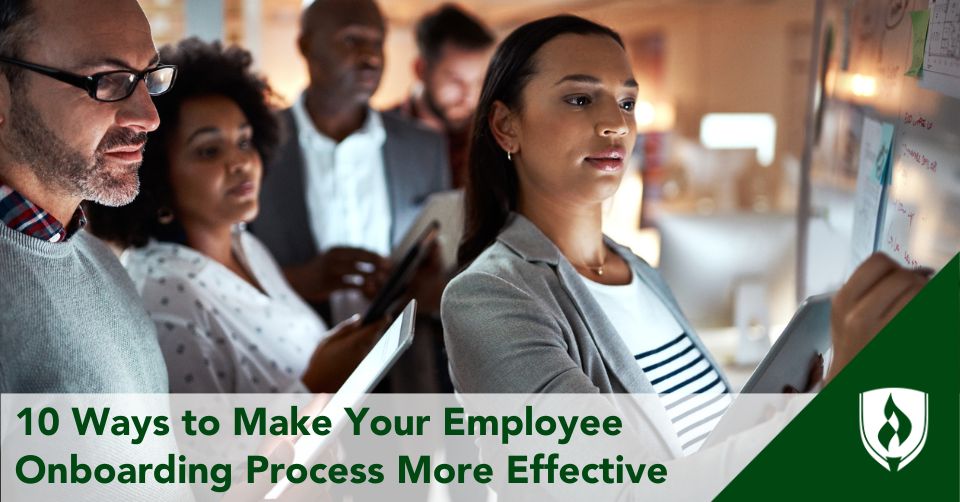
Onboarding can make or break a new hire's integration into the company. A good onboarding experience launches your employees into quicker usefulness in their role and affirms their decision to go with your company. A negative onboarding experience can cause your sought-after talent to walk right out the door.
If you can master a successful employee onboarding process, then you'll increase recruitment and retention at your company and cause less burnout. Whether you decide to use a formal onboarding program or rely on hiring managers to create one for their departments, make the employee onboarding experience a positive one.
You'll be glad you did.
What is employee onboarding?
Employee onboarding is the process of not only welcoming, but integrating your new hires into an organization. It includes more than just completing paperwork or touring the office. It’s about preparing people to succeed both short and long-term.
A solid employee onboarding process gives new team members the tools, knowledge, and confidence they need to do their jobs well. It connects them to their teams and the company’s values. It also helps them understand expectations and navigate their new work environment.
When done right, the onboarding experience supports employee engagement and strengthens long-term employee retention. And that (as HR professionals know) is well worth the effort.
Example of an effective onboarding process
When the entire onboarding process is done well, it makes a strong first impression. It builds employee satisfaction from day one and sets new employees up for long-term success. But when the onboarding experience is disorganized, it can leave new employees feeling lost and disconnected. Here are two examples.
It’s early on Monday morning, and Rachel has just arrived at Main Street Children’s Hospital for her first day as a non-clinical manager. Up to this moment, she's only had her job interviews and the job description to go on. Today is the day she transitions from a prospective employee to an employee.
She shows the digital badge she received via email on Friday to the security officer who also tells her where to park. Once inside, she’s greeted by the receptionist and directed to a conference room. There, she finds a notebook, pens, a binder of useful information (like login information for new platforms and a copy of company policies) and her badge—plus a welcome note from her new manager.
Within minutes, a recruiter appears and invites Rachel to meet her new team. Several colleagues ask if she’d like to join them for lunch.
Now, let's say a few streets away, Rye is starting his new role as a project manager at The Remington, a luxury resort. He picked out his suit days ago and hasn’t stopped talking about the opportunity since getting his offer letter.
But when he pulls up, the parking lot is being repaved, and there’s no message or email with alternative instructions. After circling for a while, he finds a public lot three blocks away and walks in late. The receptionist doesn’t know who he is or where he is supposed to be. They click around on their computer, trying to figure out where Rye is supposed to go and eventually ask him to sit at a cluttered desk near old electronics and office supplies while they “figure things out.”
These moments might only represent the first quarter of the first day, but even if both employees go on to complete a basically identical employee orientation, only one of these new hires ends their first day feeling seen, welcomed and excited to be part of something.
The other is left wondering if they made the right decision.
10 Ways to improve the employee onboarding process
Rachel’s experience at Main Street Children’s Hospital highlights what a strong onboarding process looks like. She’s welcomed warmly, has all the tools she needs, and is immediately included in team interactions. The company clearly made an effort to start the employee onboarding process before she even walked through the door.
In contrast, Rye's first day at The Remington sends a very different message. The lack of communication, preparation and support leaves him feeling overlooked. His first impression of the organization is not about culture or values. Instead, it established a sense of confusion and disconnection.
These stories illustrate just how much a structured employee onboarding program can impact how new hires feel on day one. The difference in experience shapes how engaged, confident and valued employees feel moving forward. Professional first impressions go beyond a handshake or smile. They include how well a company introduces a new hire to their role, their team, and the organization’s mission and culture.
A well-designed onboarding process makes new hires feel supported and included from the start. It communicates that their success matters. This first phase shapes how new employees see their place in the company and whether they feel confident stepping into their responsibilities.
Organizations that prioritize employee onboarding set a tone of care, clarity, and commitment. Those who skip or rush this step risk losing connection and losing people.
But these things don't just magically fall into place. It takes intentionality from the organization and from human resources (HR) professionals to connect all the dots that need connecting.
1. Start right away, as soon as they sign the contract
Good organizations utilize something called "pre-boarding."
Pre-boarding happens after a job offer is accepted but before the official start date. It’s a key part of the employee onboarding process that’s often overlooked.
HR leaders should basically imagine the entire process of a new employee's experience from the job acceptance to the end of their first week--to figure out all the logistics that need to be arranged.
Some organizations stop communicating after the employee accepts the job and signs a contract. But new hires benefit from early guidance that helps them feel valued and prepared from the start.
Pre-boarding builds trust and makes for a smooth transition into the new role for the new employee and the team.
An example of what great pre-boarding looks like
Laura, an operations manager, has three new employees starting in two weeks. She’s already writing welcome emails, including a short video introduction to the team and instructions for the first day.
She has worked with IT to ensure their login credentials will be ready and has created a guide with links to internal pages and a map of the buildings. Before day one, she plans to check each workspace to make sure it’s clean, organized and stocked with pens, notepads, a coffee mug and a company t-shirt.
Pre-boarding bridges the gap between the hiring process and day one on the job for a new employee, and Laura uses the pre-boarding process to build a sense of connection and belonging before her new hires even arrive.
2. Think through all the logistics
Pre-boarding doesn’t just help new employees feel welcome; it helps them start strong. Employee onboarding is usually full of new information, crammed in at a speed that's tough for people to digest.
All of that will be much harder when those new hires you went through such trouble to recruit can't even get in the building or log in to their workspace.
Having access badges ready, login credentials in place and laptops set up allows new employees to be productive on day one. Instead of waiting around for tools and access, they can begin engaging with their new role right away. This helps them navigate and learn what they need to know, reducing the likelihood that you'll need to repeat information.
These early actions can serve as an informal onboarding checklist for managers across the organization as well. Beginning with the practical logistics can help managers stay consistent from one new employee to the next.
When pre-boarding is done well, it reinforces the employee’s decision to join the organization. It builds early momentum and helps new hires feel included, motivated and ready to contribute.
3. Plan for the employee onboarding process to take several days (at least)
A great onboarding program doesn’t end after the first day. To set up new hires for long-term success, the onboarding process should extend over several days or even weeks.
One of the first steps in a multi-day onboarding experience is introducing the organization’s history, structure and leadership. This helps new hires understand how the company grew and where it stands today, both physically and within its industry.
Let's say a company called IzonTech just hired two new employees--Kai and Tyrell. On day one, they spend their morning learning how the company began in a dorm room 20 years ago, started by three college students with a dream of building software. Seeing how it grew from a small idea to a global SaaS organization gives these new team members a strong sense of connection and purpose.
At lunch, they meet with their future colleagues from Marketing and HR. The relaxed conversation gives them time to ask questions and start building relationships. By the end of the day, Tyrell feels confident in his decision to choose IzonTech, and Kai is excited to hear that her new role will support a major social media initiative.
4. Communicate the company's mission in interactive ways
Communicating a company’s mission and vision well involves more than reciting a statement. When new hires engage with real examples of organizational values in action, they start to see how their own work can align.
On day two of onboarding, Kai and Tyrell attend a session led by the COO titled, “The IzonTech Mission: More than a line on our website.” The presentation includes interactive polls and group chats. Each core value is paired with an employee story to show how it shaped a real decision or outcome.
By the end of the session, every attendee can name the company’s three core values and explain how their own roles support them. This experience strengthens the connection to the company culture and helps employees feel like contributors from the start.
5. Assign time for job-specific training
While much of onboarding is designed for all new hires, time must also be reserved for job-specific training. This part of the employee onboarding process gives new team members the tools and experiences they need to succeed in their specific roles.
Kai spends her third day shadowing Seng, a marketing representative. She attends a strategy meeting with designers, media buyers and digital marketers. She takes notes while Seng reviews campaign analytics and learns how to use click-through rates and web traffic data to guide marketing decisions.
Meanwhile, Tyrell works alongside Grace, a recruiter, as he trains on the company’s HR software systems. He practices using the applicant tracking system and HRIS platform while Grace offers guidance and support. He also receives links to user guides so he can continue learning after onboarding ends.
In these scenarios, each new employee had dedicated time to simply watch and practice with one of their new team members. And that element of the employee onboarding experience was on those more-tenured employees calendars as well.
6. Standardize the session for HR policies and procedures
New hires also need time to understand workplace policies, benefits and expectations. A structured onboarding session should covers the employee handbook and code of conduct while allowing space for questions.
On day four, Rochelle, an HR specialist, leads the new hires through this session. She highlights the organization’s policies on communication, conflicts of interest and anti-harassment. She also facilitates a group discussion on workplace ethics and safety, encouraging team members to apply what they’ve learned to real-world situations.
These sessions help employees understand what’s expected of them and what they can expect in return.
7. Create a 30/60/90 day plan for each new hire
An important part of the employee onboarding process is helping new hires understand what success looks like in their role. A structured 30/60/90-day plan gives new employees a roadmap. It outlines key responsibilities, goals and training milestones across their first three months.
For example, Kai and her manager meet in the first week of onboarding to map out her onboarding plan. For the first 30 days, she will focus on learning. She’s expected to complete onboarding sessions, review the company’s marketing strategy and familiarize herself with branding guidelines and tools like Google Analytics™ and Canva®.
From day 31 to 60, the focus shifts to contribution. Kai will begin managing a smaller campaign or content calendar. She’s also expected to analyze results from a previous campaign and present findings to the team.
The final phase of the process should focus on optimization. For example, Kai could lead a mini-campaign or propose a new strategy—such as an A/B test or SEO idea—designed to test and improve performance. This phased approach helps her grow into her new role with confidence and clarity.
8. Track progress and follow up with each new hire
Setting goals is important, but tracking progress and offering useful feedback is just as critical. The best onboarding programs include built-in check-ins and clear performance metrics.
Kai’s plan includes regular meetings with her manager to review milestones, answer questions and make adjustments. These conversations support her professional development and give her a chance to ask for help or feedback early on.
By breaking the onboarding timeline into clear phases, managers can provide ongoing support while helping new hires take ownership of their success.
9. Assign resources for regular support
Even with a strong 30/60/90-day plan, new hires need regular support. A successful employee onboarding program includes feedback loops and check-ins that promote clarity and growth.
Tyrell’s manager, Leon, schedules weekly 1:1 meetings during the first 30 days, then switches to biweekly check-ins through day 90. These consistent meetings give Tyrell a space to share progress, ask questions and receive support.
Leon also creates a shared Trello onboarding checklist to track tasks and goals. This tool helps both manager and employee see progress in real time, which encourages accountability and helps identify areas for extra guidance.
Additionally, Leon sets up a shared notes section in the HR team’s dashboard where Tyrell can jot down questions or comments as they come up. Any team member can respond, helping Tyrell feel supported and more connected to his new colleagues.
10. Encourage team collaboration
Accountability doesn’t just come from managers or HR—it comes from the team.
By inviting other team members to participate in the onboarding process, Leon ensures Tyrell is building relationships alongside skills. The shared dashboard encourages collaboration and shows that onboarding is a team effort, not a solo journey.
This type of structure turns new hires into contributing team members faster and sets the tone for open communication moving forward.
How to onboard remote employees
Employee onboarding can seem pretty different when your new hires are remote. But remote employees need just as much structure, support and connection as in-person hires. A successful remote onboarding process can’t rely on simply streaming face-to-face sessions.
Instead, it must be intentional about communication, training and culture-building.
Many organizations use employee onboarding software to track progress, assign training modules and streamline communication. This includes video conferencing tools, pre-recorded presentations, digital onboarding checklists and interactive employee handbooks help bridge the gap. These tools are part of a larger employee onboarding experience designed to keep remote team members informed and engaged, no matter where they work.
When remote onboarding is done well, it mirrors the support of in-person programs. It fosters a sense of belonging and gives remote employees the same clarity around job responsibilities, expectations and tools.
Remote Employee Onboarding in Action
Let's say at IzonTech, remote new hires Leah and Woobeen are joining the team from Colorado and South Korea. Because of time zone differences, the head of HR pairs each of them with a senior team member located in a similar region.
These seasoned employees walk them through modules and digital tools using video calls and screen sharing. Each new hire is also given access to a sandbox environment where they can practice using the platforms required for their role. Leah receives a welcome message and local café gift card from her manager. Woobeen receives daily check-ins from different team members.
By the end of their onboarding experience, both Leah and Woobeen feel confident in their roles and connected to their new teams. This remote onboarding process reflects the same care, structure and intentionality given to on-site employees.
Employee onboarding goes beyond a checklist
Effective employee onboarding is not just an onboarding checklist of forms, passwords and signatures. It’s a strategic investment in each new hire’s success and long-term contribution.
HR professionals and business leaders know retention has a higher return on investment (ROI) than replacement. You go through lots of work to attract and recruit quality employees for your company. So why wouldn't you take the extra time and intention to make sure their integration is thorough and productive?
When new employees feel supported, informed and connected early on, they are more likely to stay and grow with the organization. In short, excellent onboarding doesn’t just welcome new employees—it empowers them. And that kind of start benefits everyone in an organization.
If you are the kind of person who believes in doing something well, there are so many business roles, especially in HR and Organizational Leadership that could use your brain! The truth is, your workforce will benefit enormously from a little extra forethought, and it doesn't stop at employee onboarding.
Check out 9 Reasons You Can’t Ignore the Importance of Training and Development in the Workplace.
1Canva® is a registered trademark of Canva Pty. Ltd.
2Google Analytics™ is a trademark of Google LLC




